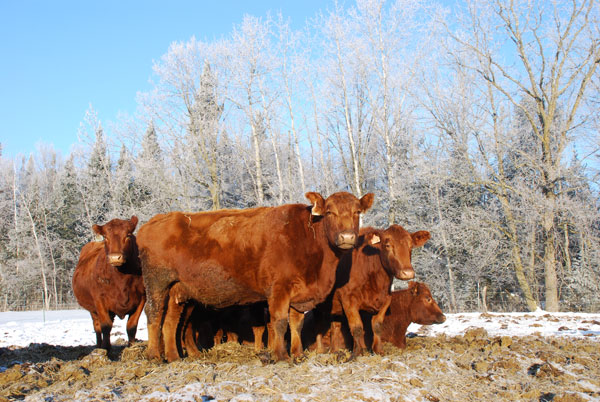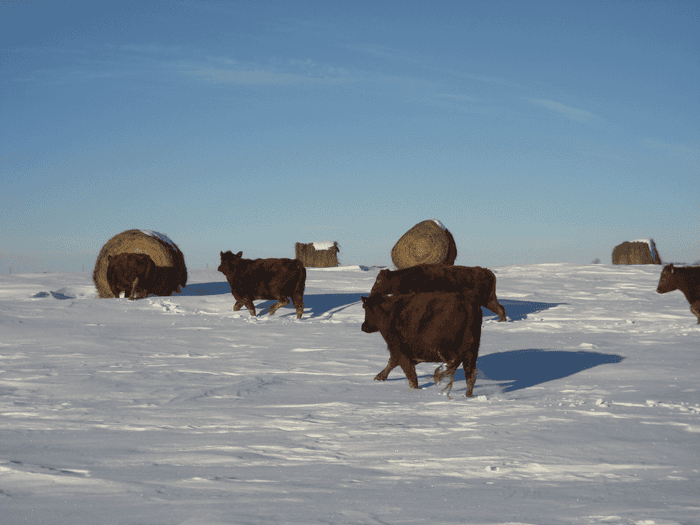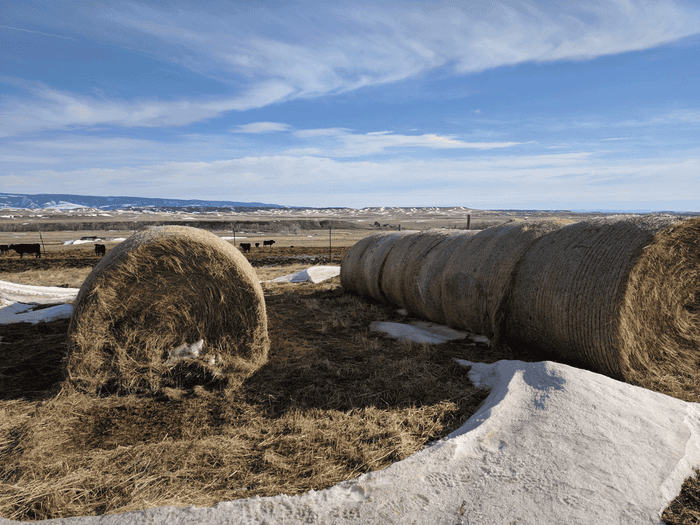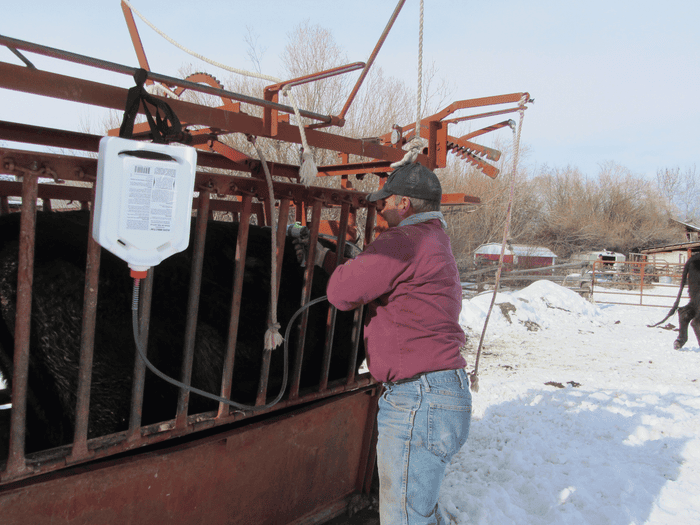How to keep your cowherd healthy this winter
Start now to get your cows ready for colder weather ahead. Here's a solid refresher on winter cowherd care.
October 2, 2018

Keeping your cattle healthy during the stress of colder winter temperatures is easy. Kind of. Cattle health is influenced by many factors, including nutrition, environment, stress and exposure to pathogens.
Going into winter, especially in cold climates that necessitate more feed to produce body heat and alleviate effects of cold stress, cattle need to be in good body condition and have adequate forage. So, adequate nutrition is likely your most important defense against winter health problems — but it’s not the only one.
Fall is a good time to score body condition when vaccinating and preg-checking. Then, you can sort off thinner cows and start feeding them earlier, to get weight back on before cold weather arrives.
Shannon Williams, Lemhi County Extension educator, Salmon, Idaho, says the main things that are important for winter herd health are to test forages and have a good nutrition plan, and work with your veterinarian on herd health.
Health depends on proper nutrition for a strong immune system. Thin cattle are more vulnerable to cold stress and may have weaker immune systems. Pregnant cows need more feed in winter because the fetus will be growing during the harshest months.
Feeding strategies
Williams recommends nutritional analyses of hay, to know if nutrient levels are adequate or if supplements are needed. “Also, this can help when making decisions regarding which hay or stacks will be fed to which cattle — such as weaned calves, bred heifers, young cows or bulls,” she says. Different classes of cattle have different needs; feed your highest-quality hay to the younger animals that are still growing.
“Some of your best hay may be on the end of the stack if it’s the last hay you put up, but you may want to save it for weanlings or first-calvers. You don’t want to feed up your best hay first and then realize you needed it later,” says Williams.
“If you are feeding grain hay [oats, barley, etc.] test nitrate levels to know if you need to mix it with other hay, or which animals you can safely feed it to,” Williams says. A hay analysis costs only $25 to $50, depending on what you want to test for. The loss of one cow (or an abortion) would pay for a lot of hay testing.

When snow covers the ground too deeply for cattle to paw through to get a bite, bale grazing or other ways of providing feed for the herd comes into play. Good winter nutrition coupled with a good herd health program not only helps pay the bills now, but also later at calving and weaning.
When buying hay, don’t be afraid to ask for a nutritional analysis, and check nitrate levels. “If the seller doesn’t have hay tested, volunteer to pay for a test. If that feed doesn’t match your needs, it’s not what you want,” Williams says.
If you have some hay that’s borderline or nutritionally deficient, you need to know how to supplement it. “It helps to know what you have for feed and work out a schedule for when you need to start supplementing, and have a feeding plan.” You may want a contingency plan for bad weather, or if snow covers windrows too deeply for grazing.
A harsh winter can take a toll on cattle health. Megan Van Emon, Extension beef cattle specialist at Montana State University, says many cows on the Northern Plains went into this last winter in thin body condition.
“We struggled with the challenge of providing adequate nutrition because of drought the previous summer. We saw a lot of calf illness this calving season because calves did not have strong immunity, which went back to the cows’ inadequate nutrition during gestation,” Van Emon says. Also, cows may not have produced optimum colostrum, so calves were not protected well with maternal antibodies.
“Grain or silage are digested too quickly to have much effect on keeping cattle warm in cold weather. They need more forage; they use the rumen to maintain body heat [fermentation digestion creates heat], so using bulky feeds like hay will stay in the rumen for a longer period and help them stay warm,” she says.
“If you are feeding hay, the timing of feeding can make a difference, and making sure cattle are getting enough. You might feed twice a day and feed the majority of the ration in the afternoon or evening so they can utilize it through the night to keep warm,” says Van Emon.
Then, check the weather forecast. “If it’s 20 [degrees F] above zero and next week it’s supposed to be 40 below, increase the amount you are feeding, and be ahead of the curve,” Van Emon says.
Minerals
If you’ve tested your forage, you have a better idea what you need for a mineral program if your hay is short on selenium, copper or other important minerals. “You can work with your vet and know what to look for,” says Williams.
“In our region, cattle often have a copper deficiency, not because our soils are short on copper but because there is too much molybdenum, which ties up copper and makes it unavailable to the body. You need to know if your cattle are short on copper; you can pull some liver samples when working cattle, or get a sample if you lose a calf,” says Williams.

How good is your hay supply? It’s hard to tell without a forage analysis. Using those numbers, match your hay to the cattle and conditions. Feed the most nutritious hay to young stock or lactating cows, and use the lower-quality hay to add more filler to all rations when the weather is coldest — to aid in generation of body heat.
Water supplies
Water is an important nutrient, too. “Decide how much time you want to spend breaking ice!” says Williams. A better water system might be beneficial, making sure you have adequate water in each pen or pasture.
“Last year with the drought, many ranchers in Montana ran short of water, or the water wasn’t good-quality,” says Van Emon. “Cattle won’t eat enough if they don’t have enough water. Some water sources were high in sulfate, and we also had some nitrate issues.”
So, check your water as well as your feed. Most Extension agents can send water samples for testing. You can bring a sample to the Extension office, or the agent may come test your water, she says.
“You can buy a total dissolved solids [TDS] meter for about $15 online. This is handy to have, so you can test a water source to make sure it’s good before you turn the cows out. If it’s not, hopefully you have another water source and can fence off the bad one,” says Van Emon.
Cattle will eat snow if they don’t have water — if snow is not crusted, and if there is adequate moisture in it — but may not be able to eat enough snow to meet their water requirements. If they are grazing winter pastures and licking snow as they graze, taking a bite of grass and a lick of snow, they may do fine. If they are eating hay, a big meal all at once, they need more water.
“Sometimes on the Northern Plains, it’s very dry snow; there isn’t much moisture in it,” says Van Emon. “If there’s a bad storm, cattle may not graze. They wait out the storm and eat a little snow and manage for a day or two, but we usually can’t rely on snow for the entire winter. They need sources of fresh, clean water,” she says.
Vaccinations
Consult your vet regarding what you need for your cattle. “Make sure your vaccination program is up to date and proper protocols lined out for what you are giving,” says Williams. “You need a plan for timing vaccination if you use scour vaccines ahead of calving.”

Adequate winter nutrition and good health management are nearly inseparable. Without adequate nutrition, vaccines and other health products aren’t as effective. And without a strong herd health program, all the groceries in the world won’t keep health problems at bay.
Some of these can be given in the fall with your other vaccinations, and then a booster closer to calving for optimum antibody levels in colostrum. Your veterinarian can help you figure out what might be best for your own operation.
Biosecurity, clean environment
Biosecurity is as important in winter as well as summer, even if cows are not commingling with other cattle at pasture or don’t have fence-line contact with other cattle. “You still need to think about biosecurity, especially if you share hired help with another ranch, or have extra people coming to help you feed, or during calving season,” Williams says. People may bring pathogens from one ranch to another.
For example, if you are helping at a neighbor’s place and there are some sick calves there — and you simply go back to your barn and pens because you are calving, too—you may be bringing disease home, Van Emon says.
“It helps if you can keep corrals and barns clean. If you are dealing with a sick animal, make sure you are washing your boots afterward [before you go to another stall, barn, pen or lot] — and not just with water. Use a good soap or disinfectant every time you leave that area,” says Van Emon.
She had a few calls last winter from producers experiencing problems with coccidiosis: “This disease and several others can readily occur when cattle are confined in a drylot situation and commingling several groups.”
Parasites
Parasite control is also important, such as delousing all cattle before they go into winter. Many cattle also need to be dewormed, so they are not carrying a heavy load of internal parasites through winter, robbing nutrition.
You’ll want to know the best time of year for deworming, and which parasites to target; this may vary depending on where you are. It may also depend on whether your cattle are on wet pastures all summer or out on dry rangelands. Work with your local vet or Extension people to know if and when you need a parasite control program, and what it should entail.
Smith Thomas is a rancher and freelance writer based in Salmon, Idaho.
About the Author(s)
You May Also Like


.png?width=300&auto=webp&quality=80&disable=upscale)
